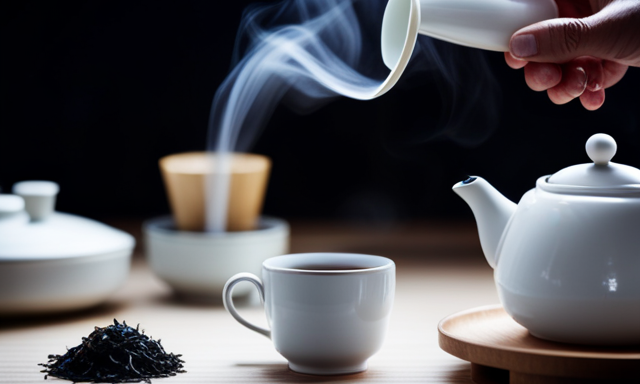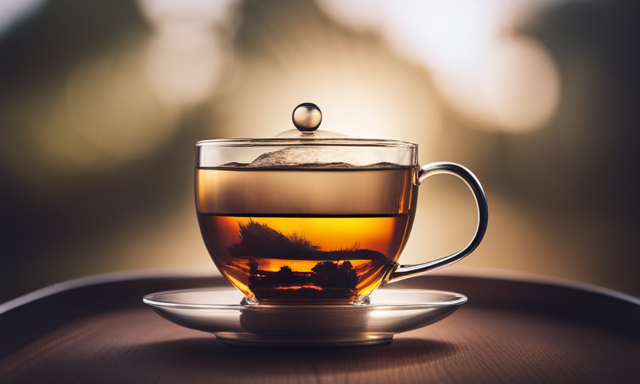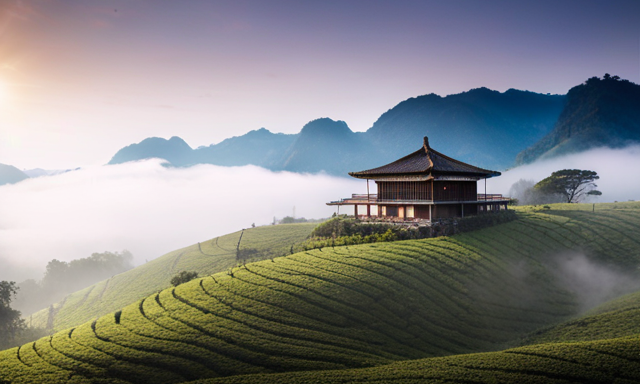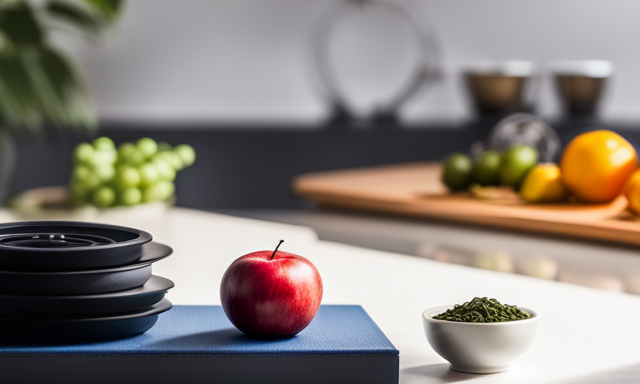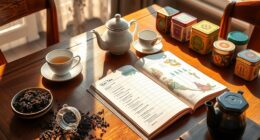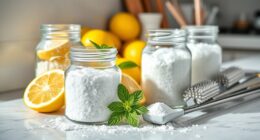Have you ever found yourself staring at a cup of oolong tea, disappointed by its lackluster flavor and aroma? Fear not, fellow tea enthusiasts, for I am here to guide you on a journey to fix that underwhelming cup. Just like a master painter meticulously adds layers of color to their canvas, perfecting the blend of oolong tea requires attention to detail and a touch of artistry.
In this article, I will share with you my tried and tested techniques to elevate your oolong tea experience from mediocre to magnificent. From understanding the different types of oolong tea to exploring various brewing methods, we will delve into the world of oolong tea and unlock its hidden potential.
So, grab your favorite teapot and join me on this flavorful adventure. Together, we will unravel the secrets of fixing oolong tea and savor every sip with satisfaction.
Key Takeaways
- Use filtered water for brewing oolong tea to ensure true flavors and quality.
- Steep oolong tea for the recommended time of 3-5 minutes to achieve optimal flavors.
- Adjust the tea-to-water ratio to create the perfect balance of flavors, using more tea leaves for a stronger brew and less for a milder taste.
- Preheat tea ware and rinse tea leaves to enhance the tea-drinking experience and remove impurities for a smoother taste.
Understand the Different Types of Oolong Tea
Now that you’re diving into the world of oolong tea, let’s explore the mesmerizing array of different types that will captivate your taste buds and leave you craving for more.
Oolong tea comes in various flavors, each offering a unique experience. From the floral notes of Tie Guan Yin to the rich, roasted taste of Da Hong Pao, there is a flavor to suit every palate.
Not only do these teas provide a delightful drinking experience, but they also come with numerous health benefits. Studies have shown that oolong tea can help boost metabolism, aid in weight loss, improve digestion, and even promote heart health.
So, whether you’re looking to savor the flavors or reap the health benefits, oolong tea has got you covered.
Now, let’s move on to the next section and learn about the importance of using the right water temperature.
Use the Right Water Temperature
Start by making sure you’re using the perfect water temperature for brewing your oolong tea. The water temperature plays a crucial role in extracting the flavors and aroma from the tea leaves. To achieve the best results, follow these steps:
-
Use filtered water: The quality of water used can greatly impact the taste of your oolong tea. Using filtered water ensures that any impurities or chlorine flavors are eliminated, allowing the true flavors of the tea to shine through.
-
Heat the water to the right temperature: Different types of oolong tea require different water temperatures. Generally, a temperature between 185-205°F (85-96°C) works well for most oolong teas. Refer to the specific instructions on your tea packaging for the recommended temperature.
-
Importance of water quality: The quality of the water used not only affects the taste but also the overall quality of your tea. Using water with a balanced mineral content can enhance the flavors and create a smoother and more enjoyable tea experience.
-
Steep for the right amount of time: Once you have your water at the perfect temperature, steep your oolong tea for the recommended time mentioned on the packaging. This will ensure that you extract the optimal flavors without over or under brewing.
Now that you’ve mastered the art of water temperature, let’s move on to steeping for the right amount of time.
Steep for the Right Amount of Time
Once you’ve got the water temperature just right, it’s time to steep your oolong tea for the perfect amount of time. Proper steeping techniques are crucial to achieving the optimal flavor and aroma in your cup.
Oolong tea is delicate, and if steeped for too long, it can become bitter and lose its complex taste. On the other hand, if steeped for too short a time, it may lack depth and richness. The ideal steeping time for oolong tea is generally between 3 and 5 minutes. However, this can vary depending on the specific variety and personal preference.
Taking the time to experiment with different steeping times will allow you to find the perfect balance that suits your taste. Proper steeping techniques ensure that you extract the full range of flavors and experience the numerous health benefits oolong tea has to offer.
So, let’s delve into the next step: adjusting the tea-to-water ratio.
Adjust the Tea-to-Water Ratio
To achieve the perfect balance of flavors, make sure you adjust the amount of tea leaves you use in relation to the amount of water you’re steeping it in. Oolong tea is delicate, and finding the ideal measurements is crucial to unlocking its full potential.
When adjusting the tea-to-water ratio, there are a few techniques you can employ. If you prefer a stronger brew, increase the amount of tea leaves while keeping the water volume constant. Conversely, if you want a milder taste, decrease the amount of tea leaves. Experiment with different adjustments until you find the perfect balance for your palate.
Once you’ve mastered the art of adjusting the tea-to-water ratio, it’s time to move on to the next step: preheating your tea ware.
Preheat Your Tea Ware
Before diving into the art of steeping, it’s essential that you take a moment to preheat your tea ware, as this will enhance the overall tea-drinking experience.
Preheating your tea ware not only warms the vessels, but it also ensures that the tea stays at the optimal temperature for a longer period.
Tea etiquette dictates that you should pour hot water into your teapot, teacups, and even the serving pitcher, allowing them to warm up before brewing the oolong tea. This step is crucial because it helps maintain the ideal temperature and preserves the delicate flavors of the tea.
Once your tea ware is preheated, you can move on to the next step of rinsing the tea leaves, which will further enhance the flavor profile of your oolong tea.
Rinse the Tea Leaves
To ensure the best flavor and aroma in your oolong tea, it is important to follow the proper steps. Now that we have preheated our tea ware, let’s move on to the next step: rinsing the tea leaves. This technique involves pouring hot water over the leaves and quickly discarding it. By doing so, we remove any impurities or dust that may be present on the leaves. Not only does this enhance the overall cleanliness of the tea, but it also allows the leaves to open up and release their full flavor potential. The benefits of rinsing include a smoother and more balanced taste, as well as a richer aroma. Now that we have rinsed the tea leaves, we can explore different brewing methods to further customize our oolong tea experience.
Explore Different Brewing Methods
Now that you’ve rinsed the tea leaves, it’s time to dive into the vast ocean of brewing methods and unlock the hidden treasures of flavor waiting to be discovered.
Oolong tea offers a wide range of different flavors, each with its own unique characteristics. By experimenting with various brewing methods, you can uncover the full spectrum of tastes that oolong tea has to offer. Whether you choose to brew it in a teapot, a gaiwan, or a traditional Chinese clay pot, each method will bring out different nuances and subtleties in the tea.
Additionally, oolong tea is known for its numerous health benefits, such as boosting metabolism, improving digestion, and promoting heart health. By exploring different brewing methods, you not only enhance the flavor but also maximize the potential health benefits of your oolong tea.
Now, let’s move on to the next section and learn how to store your oolong tea properly.
Store Your Oolong Tea Properly
Discover the secret to preserving the rich and delicate flavors of your oolong tea by mastering the art of proper storage. Proper storage is crucial to maintain the freshness and quality of your oolong tea.
Here are three key steps to ensure its longevity:
-
Keep it airtight: Store your oolong tea in an airtight container to prevent exposure to air, moisture, and odors. This will help retain its aroma and flavor for a longer period.
-
Avoid sunlight and heat: Oolong tea is sensitive to light and heat, which can degrade its quality. Store it in a cool, dark place away from direct sunlight and high temperatures.
-
Manage humidity: Excessive humidity can cause your oolong tea to absorb moisture, leading to spoilage. Store it in a dry environment and consider using moisture-absorbing packets to maintain the ideal humidity level.
Proper storage not only preserves the taste and aroma of your oolong tea but also ensures you reap its numerous health benefits. Now, let’s explore how tea accessories can enhance your brewing experience.
Experiment with Tea Accessories
Enhance your brewing experience by adding a touch of flair with tea accessories, turning your tea time into a delightful sensory journey. Experimenting with tea infusers and trying different brewing vessels can elevate the flavors and aromas of your oolong tea.
To start, consider using a tea infuser that allows the leaves to unfurl and release their full potential. Mesh infusers or tea balls are popular choices, but you can also explore unique options like glass teapots with built-in infusers or even bamboo tea strainers for a traditional feel.
Additionally, the choice of brewing vessel can impact the taste of your oolong tea. Ceramic or clay teapots are known for their ability to retain heat and enhance the tea’s complexity. Glass or porcelain cups can showcase the tea’s color and clarity. By experimenting with different accessories, you can discover new dimensions of flavor and aroma in your oolong tea.
Transitioning into the next section, remember that while accessories can enhance your tea experience, it’s equally important to practice patience and enjoy the process.
Practice Patience and Enjoy the Process
Take a moment to savor the journey and fully embrace the process of brewing your favorite cup of tea. It’s not just about the end result; it’s about the experience and the mindfulness that comes with it. Here are four ways to enhance your tea brewing process and fully appreciate the aroma:
-
Set the mood: Create a calming atmosphere by dimming the lights, playing soft music, or lighting a scented candle. This will help you relax and fully immerse yourself in the tea brewing experience.
-
Engage your senses: As you prepare your oolong tea, take a moment to appreciate the aroma of the dry tea leaves. Inhale deeply and let the fragrance transport you to a place of tranquility.
-
Be patient: Allow the tea to steep for the recommended amount of time. Don’t rush the process; instead, practice patience and let the flavors develop fully.
-
Reflect and appreciate: As you sip your perfectly brewed oolong tea, take a moment to reflect on the process and appreciate the effort you’ve put into it. Notice the flavors, the texture, and how the tea makes you feel. Embrace the present moment and enjoy every sip.
Frequently Asked Questions
Can I use tap water to make oolong tea?
Yes, tap water can be used to make oolong tea, but using filtered water is recommended for a better taste. However, using spring water for oolong tea offers additional benefits, such as enhancing the tea’s natural flavors and aromas.
Can I reuse oolong tea leaves for multiple steepings?
Yes, you can reuse oolong tea leaves for multiple steepings. It’s a great way to fully extract the flavors and benefits from the leaves. Each steeping brings out different nuances, giving you a more complex and satisfying tea experience.
What is the ideal water temperature for brewing oolong tea?
The ideal water temperature for brewing oolong tea is around 185-205°F. This range allows for the perfect balance of flavor and aroma. It is important to note that different oolong tea varieties may have slightly different temperature preferences for optimal brewing.
Should I rinse the tea leaves before brewing oolong tea?
Rinsing oolong tea leaves before brewing can remove any dust or impurities, enhancing the flavor and aroma. However, alternatives like preheating the teapot or using high-quality leaves can also yield excellent results without the need for rinsing.
How long can I store oolong tea before it goes bad?
Oolong tea can be stored for 1-2 years if properly stored in an airtight container away from light, heat, and moisture. Signs of it going bad include a stale smell and taste.
Conclusion
In conclusion, mastering the art of fixing oolong tea requires a deep understanding of its nuances and a commitment to the brewing process. By familiarizing yourself with the various types of oolong tea and adjusting factors such as water temperature, steeping time, and tea-to-water ratio, you can enhance the flavors and aromas of your cup.
Preheating your tea ware, exploring different brewing methods, and properly storing your oolong tea will further elevate your tea-drinking experience. Remember, patience is key, and with practice, you can create a truly exquisite cup of oolong tea that’ll delight your senses.

